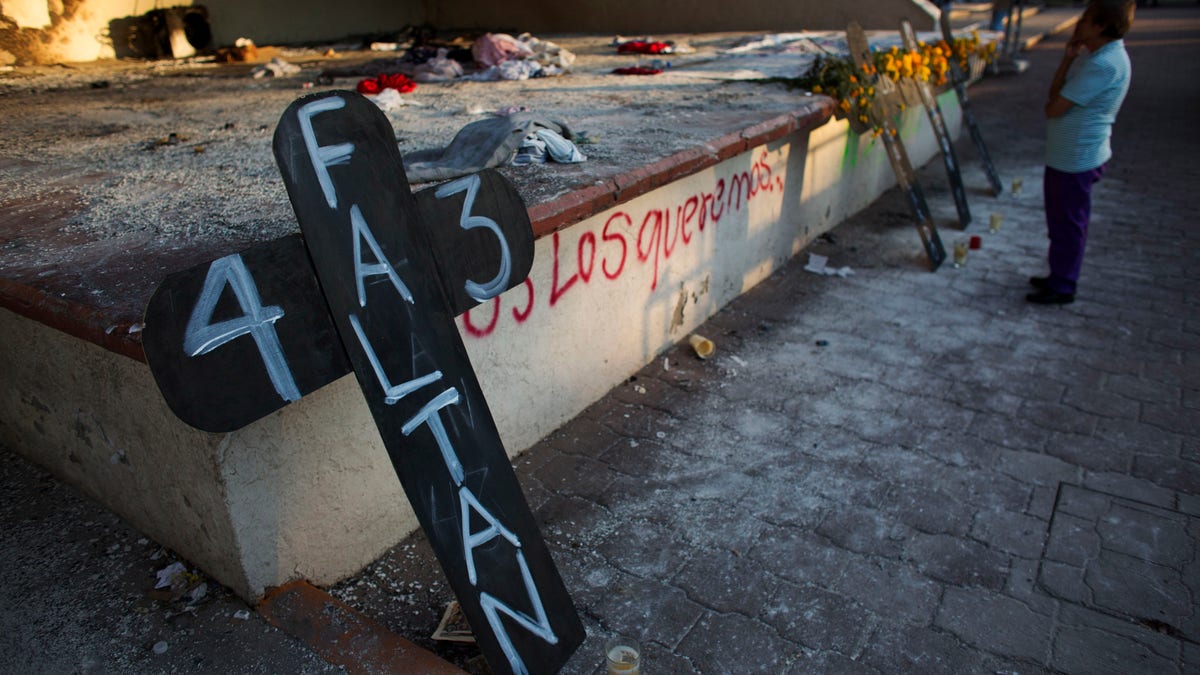
FILE - In this Oct. 28, 2014, file photo, a local resident pauses to contemplate crosses set to remember 43 missing students, in front of the burnt town hall, in Iguala, Mexico. Argentine forensics experts on Saturday Feb. 7, 2015, questioned Mexicoâs investigation into the disappearance of 43 students, saying the evidence doesnât support the governmentâs conclusion the youths were killed and burned to ashes. (AP Photo/Rebecca Blackwell, File)
MEXICO CITY (AP) – A team of Argentine forensics experts is questioning Mexico's probe of the disappearance of 43 students, saying that the evidence doesn't support the government's conclusion and that it should be allowed to investigate all theories.
The Argentine Forensic Anthropologists team, hired on behalf of the victims' parents as an independent party, issued what it said was a list of discrepancies in the case. The team had access to forensic evidence and crime scenes along with federal prosecutors and Mexico's own forensic investigators.
Its statement said Mexico's government presented biased analyses of the scientific evidence to support its conclusion that the youths were killed, their bodies burned to ashes in Cocula in southern Guerrero state and their remains thrown into a river to hide the evidence. So far only one of the students has been identified from charred remains found at the river.
The team "would like to reiterate that it doesn't exclude the possibility that some of the students met the fate described by the attorney general," the experts said in the statement issued after they met with parents. "But in our opinion there is no scientific evidence to support that in the Cocula garbage dump."
The Attorney General's Office didn't respond Saturday to requests for comment on the statement from the Argentine team, which is a nonprofit forensic science organization that investigates human right violations around the world. It was established in 1984 to investigate cases of at least 9,000 missing under Argentina's 1976-1983 military dictatorship.
- In Mexico City, 43 missing students honored by teachers college marching band
- Children’s hospital explosion in Mexico
- Hundreds occupy Acapulco Airport to protest 43 missing students in Mexico
- In Mexico City, a day of protest, a night of unrest over 43 missing students
- Best sports pix of the week
- Kim Kardashian arrives in Reynosa, Mexico – as a piñata
- Mexico’s missing students impacts Acapulco tourism
Attorney General Jesus Murillo Karam said Jan. 27 that based on 39 confessions, 386 declarations, 487 forensic tests, 16 raids and two reconstructions, investigators concluded that municipal police arrested the youths in the city of Iguala on Sept. 26 and handed them over to the Guerreros Unidos cartel. The government alleges gang members killed the students, burned their corpses into the next day using a huge pyre and disposed of the ashes.
Many groups inside Mexico and abroad have questioned Murillo Karam's conclusion as implausible, including that the temperature of an open-air fire could reach that of a crematorium oven and turn 43 bodies to ash.
According to the Argentine team's statement, there was satellite evidence of many fires at the same dump in the last four years. The team found human remains at the dump that did not belong to the students, including a tooth belonging to a set of dentures. None of the students wore dentures.
The team noted the Attorney General's Office made mistakes in 20 genetic profiles collected from family members of the 43 students that made them unusable for DNA matches. It said such errors are unusual as the process of collecting material is simple.
The prosecutor's office also allowed the dump, a key crime scene, to go unguarded for several weeks, permitting anyone to plant or manipulate evidence, the team said. It said its members were not present at key moments in the investigation, including when the remains were first found in and along a river and during a Nov. 15 trip to the garbage dump when prosecutors said they found 42 shell casings. The site had not been guarded at that point.
The team said it is important that it have access to the initial chain of custody of the remains found at the river, where a bone fragment was found that led to the identification of only one of the students, Alexander Mora.
Murrillo Karam's January press conference was seen as an effort by the government to finally close the case, which has caused significant political turmoil inside Mexico and protests at home and abroad. He later said he was not trying to close the case.
